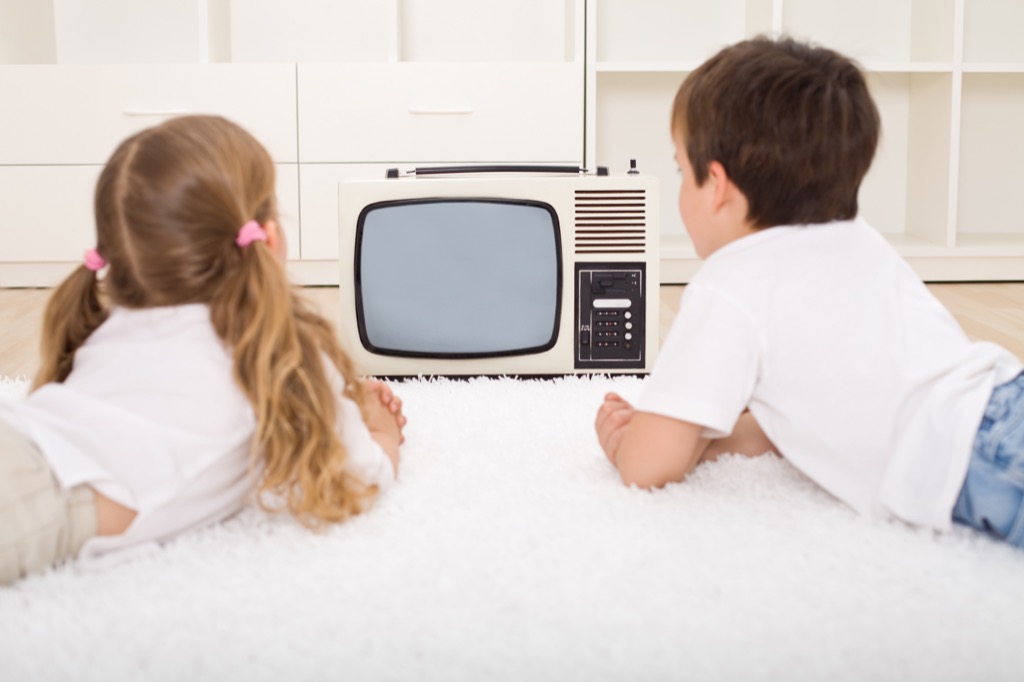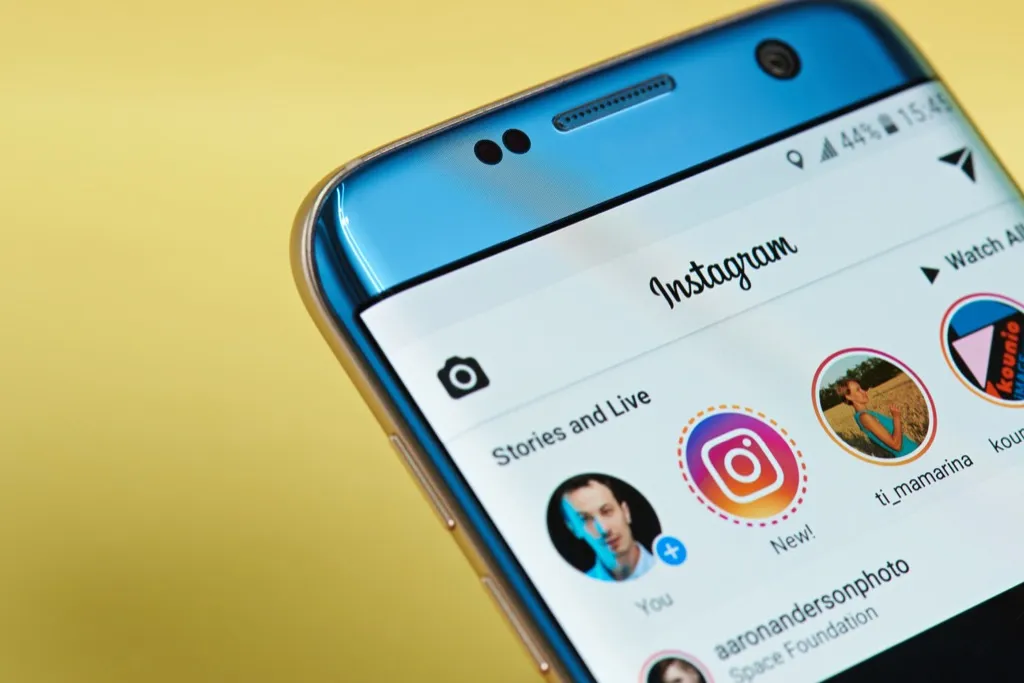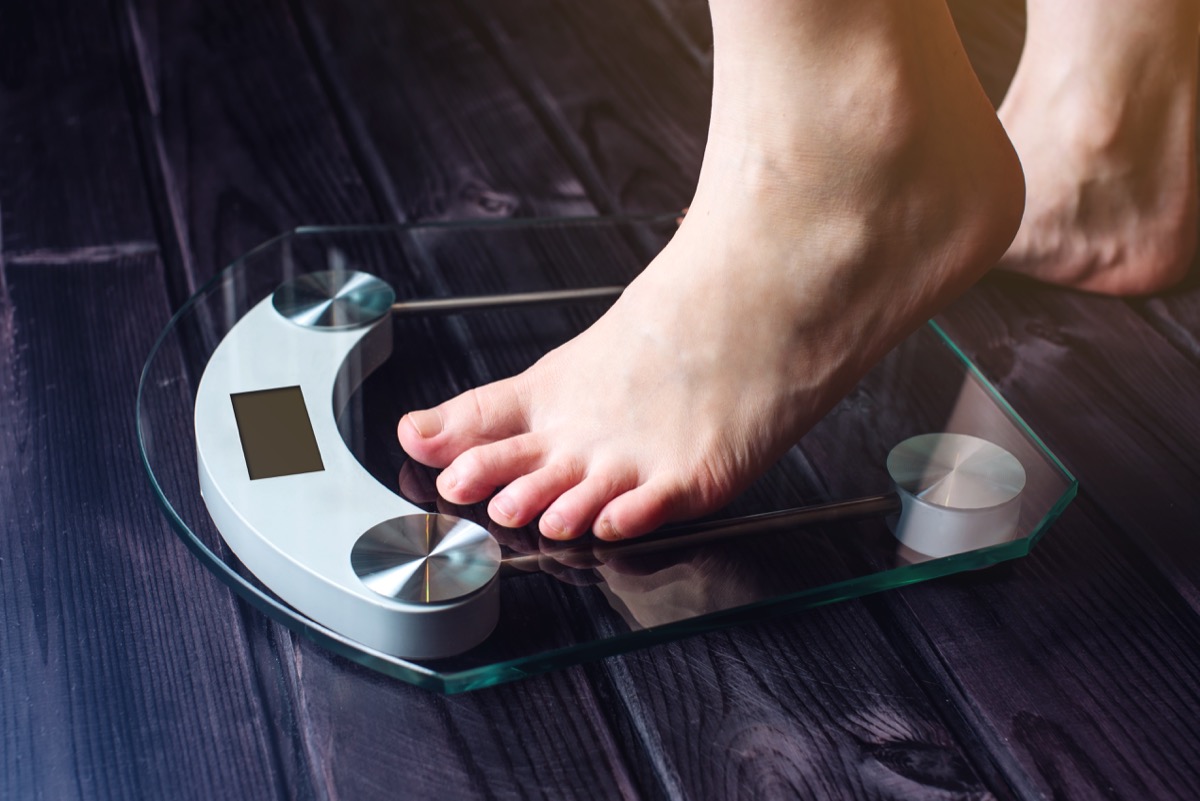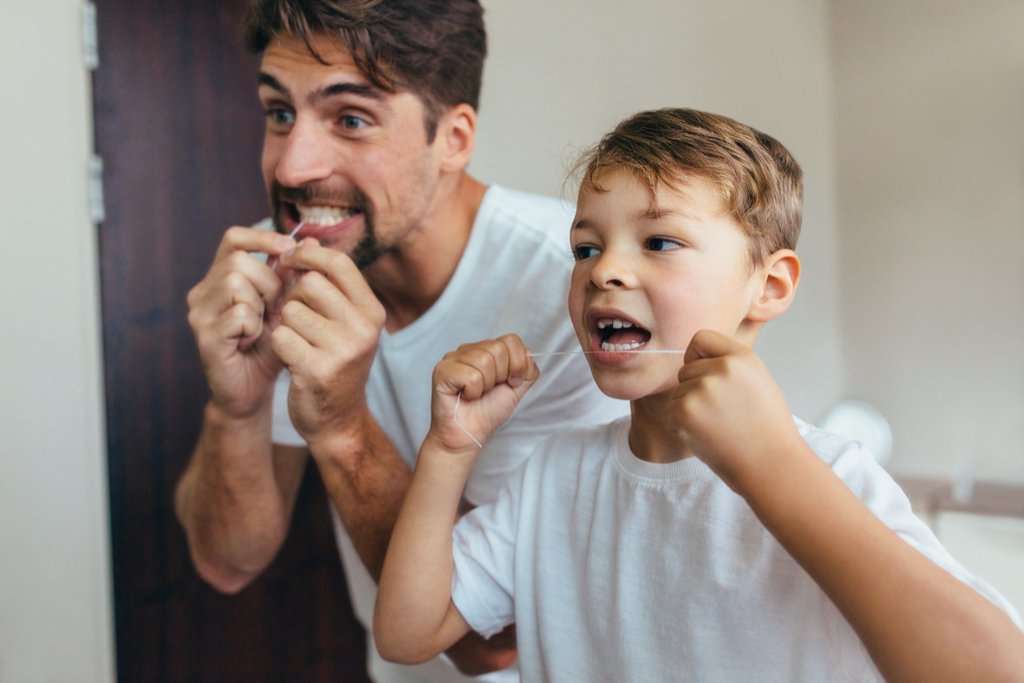30 Ways Being a Kid Has Changed in the Past 30 Years
For when your nephew responds with "TL;DR" to your handwritten birthday card.

If you long for the halcyon days of your own childhood, when things were simpler, easier, and nobody's parents tracked their every move with a GPS watch, you're not alone. "Today, childhood is much different," says Dr. Jaime Kulaga, Ph.D., a licensed mental health counselor. A result of technological and social changes, "stress is at a whole new level for both parents and children," she says.
So, beside the obvious—the advent of cell phones, personal computers, and Ariana Grande—how is the world a different place for kids than it was just three decades ago? Herein, we've rounded up the 30 biggest childhood changes in the past thirty years. But before you plan to disguise yourself and re-enlist in high school to relive your glory days, be warned: homework is still very much a thing.
1
There's less face-to-face communication.

Just a few decades ago, when you wanted to hang out with your friend, that meant actually seeing them in person. Today, it just means picking up your phone. "There is a fundamental lack of physical activity required for interaction with peers in our children's lives," explains Erika Miley, M.Ed., LMHC, a mental and sexual health therapist. "The impact is likely going to be in…the small skills we learn through body language and face-to-face interaction." While much of human communication has traditionally been handled through facial expression and body language, she says, "social media and text messages do not give us those cues."
2
There's more access to information.

"This generation has unlimited access to information," says Miley. While it's difficult to say how that will affect kids down the line, Miley reports her own experiences finding her six-year-old "agitated, tearful, and absolutely fall[ing] apart" due to a YouTube video. In addition, she says, screens have been shown to impact both sleep and behavior. "Parents today have a lot of information to monitor for their children," she explains. "It is a daunting task that feels at times impossible."
3
Everyone has a cell phone.

Remember when only adults had cell phones? Today's generation is so connected they make two-way pagers look like soup cans on a string. According to a Pew poll from 2018, 95 percent of teens have access to a smartphone, while 45 percent report being online "almost constantly." And it starts young: one study found that 12 is the most common age for a child to receive their first mobile phone.
4
Kids spend more time staring at screens than outdoors.

"Thirty years ago, childhood was all about playing outside," says Dr. Kulaga. "Nowadays, children play on their screens and the imagination is created for them." The difference is that, while connected globally through networks, children remain solo during playtime.
This creates a "more 'me' focused" socialization, she explains. Validated by likes and follows, she warns, kids may wind up with "a superficial and unfulfilled self down the road."
5
Seat belts are no longer optional.

For the longest time, seatbelt use was voluntary. The smart kids locked themselves in, while those too-cool-for-school let it all hang out, hoping to prove their daredevil instincts. In 1984, however, adults finally realized just how essential seat belts were to surviving a crash, passing the first seat belt law in the United States. Since then, the trend has slowly spread, and now there is a law regulating front seat belt use in every state in the nation. Only twenty-eight of those states, meanwhile, enforce rear seat belt use, as well.
6
Kids have more people to compare themselves to than ever.

"Social media has increased how much people compare themselves to others," says Dr. Kulaga. Lacking the proper perspective that comes with age, "children and teens often have the never-ending stress of keeping up with the Joneses." Comparing the highlight-reel that is social media to their everyday lives—while failing to grasp the crucial difference between the two—kids often incur "feeling of depression, anxiety, and jealousy at a very young age," she explains.
7
Everything embarrassment has the potential to be shared.

"Back in the day, you could do something stupid or embarrassing and then it was forgotten relatively quickly," says Dr. Kulaga. "Nowadays, if you do something embarrassing, it is posted on social media and shared out so that it goes viral."
Coupled with the fact that teens live in the now by nature, she explains, it's very complicated for them to deal with this new reality in which an inappropriate picture from a party can "hurt their futures significantly." After all, kids aren't the best forecasters: remember when you were absolutely sure you were going to grow up to be cowboy?
8
There's no hiding your location.

In simpler times, if you wanted to know where a child was, you called all the neighborhood parents and asked if they had seen them. Now, "smartphones have tracking on them….[and] social media platforms can automatically post your location for you," says Dr. Kulaga.
While it seems like this would largely keep kids out of trouble, she explains that it leads to its own difficulties: "mom can always know where her child is…[and] so can everyone else." The possibility of this feature being abused by strangers with bad intentions causes high anxiety for children who need to straddle the line between checking in with parents and staying safe. Thus what appeared to be a safety-enabling technology has actually turned into a more of a mixed bag and a cause for concern.
9
ADHD is recognized.

Throughout much of history, if you misbehaved in class, you were promptly beaten, scolded, or removed from the premises. Beginning in 1987, however, childhood hyperactivity and inattention began to be described as the symptoms of ADHD—Attention Deficit Hyperactivity Disorder. While acceptance of this new understanding—and associated teaching methods—has been slow, the term itself has become widespread in education, media, and daily life. As of 2014, 6.4 million American children have been diagnosed with ADHD.
10
There are more tests than ever.

Yes, there have always been tests. But ever since President Bush signed the No Child Left Behind Act in 2002, the number of standardized tests taken during childhood has skyrocketed. As of 2015, researchers found that students were taking, on average, 112 district-wide tests between pre-K and 12th grade. That's a whole lot of pencils, stress, and Scantrons.
11
Food allergies are far more common.

If it seems like today's kids are being much more careful about eating nuts and other allergy-causing foods around their peers, it's because they have to be. According to FARE, food allergies in U.S. children increased by 50 percent between 1997 and 2011, while tree nut allergies more than tripled in the same time. There's disagreement on the cause of these changes, but either way, it's safe to say today's kids have a much more uneasy relationship with food.
12
E-cigarettes have replaced the real thing.

Just when you thought smoking was going by the wayside, e-cigarettes enter the picture. With their scentless vapor clouds and push-of-a-button use, it's not uncommon to see kids in the back row of a science class billowing like smokestacks while their teacher's back is turned. In fact, according to a survey of high schoolers, almost a full 10 percent of 8th graders reported e-cigarette usage, while 16 percent of 12th graders did so.
13
Kids are heavier.

Mirroring their adult counterparts, children are more overweight now than ever. According to the CDC, one in 5 children between six and 19 years old is obese, a threefold increase since the 1970s. A confluence of unhealthy school meals, sedentary lifestyles, and poverty, this is one of the more unfortunate ways childhood has changed over the past 30 years.
14
Families are more diverse.

Growing up, kids were frequently told that a family consists of two married parents—a man and a woman—and an array of children. However, with a changing understanding of gender, as well as the stateside legalization of same-sex marriage in 2015, a family is no longer so clearly defined. Whether it be two moms, two dads, a single parent, or two non-binary individuals raising a child together, the word "family" has taken on many more possible meanings in the past 30 years.
15
You can watch TV whenever and wherever.

Remember when you used to have to watch things at a certain, specific time—the same time everyone else in the country was tuning in? Well, streaming has gotten rid of all that, leading to the "binge-watching" phenomenon, among other dubious benefits. TV, meanwhile, is heading towards the same fate as the dinosaurs, only to be remembered by a few fossilized cable boxes.
As of this summer, for example, the popularity of streaming services had officially overtaken that of traditional broadcasters in the UK, with the US likely to soon follow suit.
16
Wikipedia has replaced the encyclopedia.

First there were books, then there were encyclopedias, then there was the internet, and, finally, there was Wikipedia. Launched in 2001, Wikipedia quickly became the go-to source for all teens' research needs, leaving school librarians twiddling their thumbs. It also led to a chorus of hoarse teachers constantly reminding their students that, "No, Wikipedia is not a primary source and no, you can't quote from it." As of today, Wikipedia is the fifth most popular website in the world.
17
Blackboards have been replaced with SMART Boards.

Remember when a teacher would punish an unruly student by making him or her clean the blackboard erasers, leaving them coated in a thin white film for the rest of the day? Fast forward to the present and blackboards have all but disappeared from the classroom, replaced by the interactive whiteboard, the SMART Board. With a dazzling array and features and capabilities, it's no wonder SMART technology quickly swept the nation, with the company installing its two millionth unit in 2011. Still, how is the present generation supposed to describe an awful, ear-splitting noise when they've never experienced the sensation of nails scraping on a chalkboard?
18
SparkNotes made not reading for class infinitely easier.

Regardless of the generation they were raised in, kids sometimes skip out on their homework assignments. The creation of SparkNotes in 1999, however, made it a lost easier to appear as if they had actually done the work assigned to them. The book summary and study-notes giant is now the go-to site for every kid who can't be bothered to crack open Catch In The Rye. It's become so popular, in fact, that "getting the SparkNotes" is a generic name for just about any book summary you can find.
19
Kids use text speak adults don't understand.

If you had never used a cell phone, you'd be mighty confused to hear kids these days talk. SMH, OMG, and TL;DR are just a few of the neologisms carried over by the present generation from their phones to their in-person conversations. Sure, they don't save as much thumb-energy when they are spoken as compared to when they are typed, but at the very least these terms make their discussions largely impenetrable—not to mention unbearable—to adult ears.
20
Pluto is no longer a planet.

For most people, a few key mnemonic devices made remembering those not-entirely-thrilling lessons learned in school a whole lot easier: Please Excuse My Dear Aunt Sally, Every Good Boy Deserves Fudge, and Kids Prefer Cheese Over Fried Green Spinach, to name just a few. With the reclassification of Pluto in 2006 to a "dwarf planet," however, My Very Excited Mother Just Served Us Nine Pies lost its "P."
21
Adults now dress like kids to go to work.

The suit and tie used to signal that its wearer was no longer a child, but a fully grown adult, immersed in the world of serious business. In recent years, however, business wear has become decidedly more casual, blending the line between recreational wear and work attire. It's now not uncommon to see adults dressed like kids—sneakers, T-shirts, and jeans—heading into work on Monday morning. In fact, according to a poll published in The Independent in 2018, only one in 10 employees was found to still wear a suit to work.
22
The world is a safer place

According to Child Trends, mortality rates for infants, children, and teens, have all fallen significantly—in the case of infants, over 50 percent—since 1980. While the world may not feel any safer—and in many cases isn't—the American kid, at least, finds him or herself in a favorable position, longevity-wise, relative to earlier generations.
23
AIM has come and gone.

AOL Instant Messaging, or AIM, for short, was, in its heyday, the preferred mode of communication for every middle- and high- schooler in the nation. Launched in 1997, the service quickly overtook the afternoons of serious studiers, star athletes, and slackers alike. If you weren't logged on, you were likely to arrive at school the next day hopelessly confused by the developments that had occurred the night prior in cyberspace.
With the rise of the smartphone, however, AIM cooled off, officially shutting down in December of last year. While the current generation of kids possesses much more nuanced and efficient modes of conversation, they'll never get to experience the excitement that came from hearing that creaky, digital door opening that signaled one of your friends had signed on.
24
Soda is no longer a go-to drink for kids.

Not too long ago, sugary sodas were the norm among kids. It was only those with hippie parents who couldn't have a can along with their lunch, and they were ridiculed mercilessly. With the increasing awareness of the negative effects of high fructose corn syrup and other forms of refined sugar, however, soda has fallen largely out of vogue among kids. In just the last ten years, for example, the CDC reports that high school soda consumption has decreased by more than a third.
25
Fathers are more involved than ever.

Over the last 20 to 30 years, according to the APA, fathers have become increasingly involved in child care. No longer solely absentee breadwinners and disciplinarians, modern fathers "come in various forms." The results, meanwhile, are positive: the APA reports that increased fatherly attention and affection "help promote children's social and emotional development."
26
Kids don't have to learn cursive anymore.

Remember sitting down in front of countless pages with dotted lines down the middle, trying to figure out how to make a cursive Z? If so, you may be among the last generation to do so. With handwriting on the decline, many schools have ceased to teach cursive writing. In fact, it wasn't even included in the Common Core Standards for ELA education.
27
"Nerds" are cool.

Back in the day, jocks were cool and nerds were not. Fast forward to the present, however, and Elon Musk is considered one of the coolest, hippest, celebrities around. Shows like The Big Bang Theory and Silicon Valley, meanwhile, showed that nerds are proper leading characters, even heroes. It may not exactly be their revenge, but the "nerds" have certainly moved up in the world.
28
An entire music library fits in your pocket.

In olden times (i.e. the 90's) , if you wanted to make a playlist for a friend or loved one, you burned a bunch of songs off of your CDs and then burned those songs back onto a clean CD. Trying to explain that to a kid nowadays, however, will likely garner a response that's something along the lines of "What is a CD and why would you set it on fire?" Sales, meanwhile, have given way to streams, with some artists being solely signed to a streaming service rather than a label or imprint.
29
The news is everywhere.

It used to be that if you wanted to know the news, you had to look for it. Nowadays, a kid is likely to be bombarded by news stories, both real and fake, throughout their time in the digital world. While kids used to only catch glimpses of current events on the front page of their parents' newspapers, today, kids see the good, bad, and ugly of world and local news every time they go online.
30
There's increased consciousness about what constitutes "healthy" food.

You can't help but shudder to think about the foods that your parents sent along with you to school. Whether it was pudding, brownies, Lunchables pizza, or even Pop Rocks, parents simply gave kids what they wanted—often what looked the most colorful in commercials.
Nowadays, parents are significantly more concerned about the nutritional content of their kid's meals. Walk around your local grocery store, and you'll find labels on snacks—even those marketed toward children—promising them to be "low fat," "heart healthy," or "high in fiber." While the word is still out on whether or not kids are getting any healthier, their parents' obsession with making them so has surely reached new heights.
To discover more amazing secrets about living your best life, click here to follow us on Instagram!





















